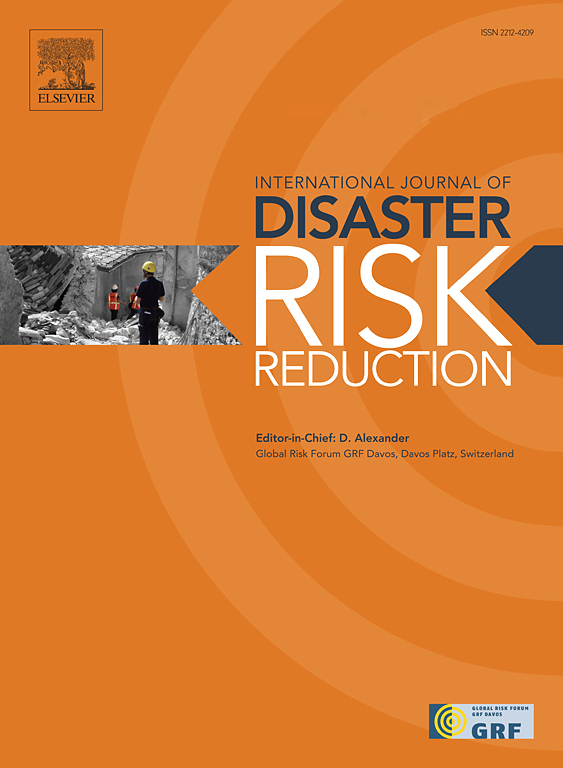How did COVID-19 pandemic impact the social integration process of poverty alleviation relocation? Insight from four rural communities
IF 4.2
1区 地球科学
Q1 GEOSCIENCES, MULTIDISCIPLINARY
International journal of disaster risk reduction
Pub Date : 2024-12-01
DOI:10.1016/j.ijdrr.2024.105001
引用次数: 0
Abstract
As China declared COVID-19 a "Category B disease," marking the conclusion of a three-year pandemic prevention and control effort, rural communities—especially those involved in Poverty Alleviation Relocation (PAR) projects—have received limited research attention despite significant economic and psychological impacts. This study investigates how COVID-19 affected social integration between locals and migrants within these relocated rural communities. Using a PAR community typology based on spatial and demographic patterns, four types were identified: centralized, adjacent, enclave, and infill. Socio-spatial isolation indices assessed social and spatial isolation levels among migrants across three phases: 2019 (before the pandemic), 2021 (during the pandemic), and 2023 (after the pandemic). Comparative analysis across phases and community types revealed varying impacts of COVID-19 prevention measures. Key findings include:
1) COVID-19 temporarily enhanced social integration, with a V-shaped evolution in social isolation levels—an initial decrease followed by an increase.
2) Centralized communities demonstrated the most sustained integration, while adjacent and infill types were moderately affected in the short term, and enclave communities were the least affected.
3) Factors such as "inequality between inside and outside groups," enhanced telecommunications, pandemic-related public activities, and spatial characteristics promoted interaction between locals and migrants.
This study enriches the understanding of COVID-19's social impacts on vulnerable communities, offering insights for disaster risk assessment and sustainable development strategies in pro-poor communities.
新冠肺炎疫情如何影响扶贫搬迁的社会融合进程?来自四个农村社区的见解
随着中国宣布COVID-19为“B类疾病”,标志着为期三年的流行病防控工作的结束,农村社区,特别是参与扶贫搬迁项目的农村社区,尽管对经济和心理产生了重大影响,但得到的研究关注有限。本研究调查了COVID-19如何影响这些重新安置的农村社区中当地人和移民之间的社会融合。使用基于空间和人口模式的PAR社区类型,确定了四种类型:集中式、邻近式、飞地式和填充式。社会空间隔离指数评估了移徙者在2019年(大流行之前)、2021年(大流行期间)和2023年(大流行之后)三个阶段的社会和空间隔离水平。不同阶段和不同社区类型的对比分析揭示了COVID-19预防措施的不同影响。主要发现包括:1)COVID-19暂时增强了社会融合,社会隔离水平呈先下降后上升的v型演变;2)集中式社区表现出最持久的融合,而邻近和填充类型在短期内受到中度影响,飞地社区受到的影响最小。电信、大流行病相关的公共活动和空间特征的加强促进了当地人与移民之间的互动。这项研究丰富了对COVID-19对弱势社区的社会影响的认识,为扶贫社区的灾害风险评估和可持续发展战略提供了见解。
本文章由计算机程序翻译,如有差异,请以英文原文为准。
求助全文
约1分钟内获得全文
求助全文
来源期刊

International journal of disaster risk reduction
GEOSCIENCES, MULTIDISCIPLINARYMETEOROLOGY-METEOROLOGY & ATMOSPHERIC SCIENCES
CiteScore
8.70
自引率
18.00%
发文量
688
审稿时长
79 days
期刊介绍:
The International Journal of Disaster Risk Reduction (IJDRR) is the journal for researchers, policymakers and practitioners across diverse disciplines: earth sciences and their implications; environmental sciences; engineering; urban studies; geography; and the social sciences. IJDRR publishes fundamental and applied research, critical reviews, policy papers and case studies with a particular focus on multi-disciplinary research that aims to reduce the impact of natural, technological, social and intentional disasters. IJDRR stimulates exchange of ideas and knowledge transfer on disaster research, mitigation, adaptation, prevention and risk reduction at all geographical scales: local, national and international.
Key topics:-
-multifaceted disaster and cascading disasters
-the development of disaster risk reduction strategies and techniques
-discussion and development of effective warning and educational systems for risk management at all levels
-disasters associated with climate change
-vulnerability analysis and vulnerability trends
-emerging risks
-resilience against disasters.
The journal particularly encourages papers that approach risk from a multi-disciplinary perspective.
 求助内容:
求助内容: 应助结果提醒方式:
应助结果提醒方式:


